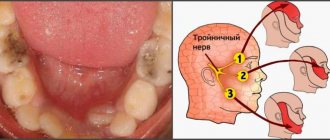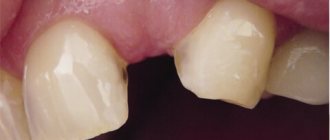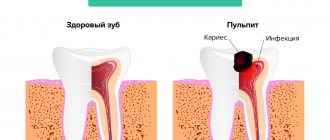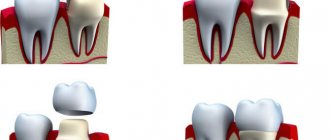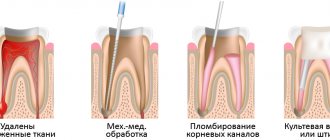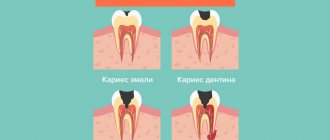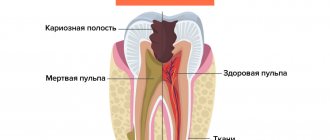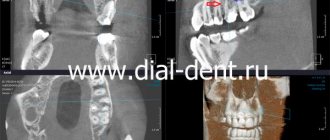December 7, 2010 - Tuesday
Pulpitis is an inflammation of the dental pulp , or, as it is often called, the dental nerve. Dental pulp is a soft tissue located in the internal cavity of the tooth. The dental pulp consists mainly of nerve fibers and blood vessels. In a healthy tooth, the pulp practically does not reveal its presence, but as soon as it becomes inflamed, a person is ready to “climb the wall” from unbearable toothache. It is for this reason that treatment of pulpitis is primarily aimed at eliminating pain symptoms.
Symptoms of pulpitis
The main symptom of acute pulpitis is the occurrence of spontaneous pain, especially at night. The pain can be paroxysmal, localized in one tooth. Hot, cold, sweet only increases the intensity of the pain. Pain from pulpitis can radiate to the ear, temple, and neck. There may be a sensation of pain even on the opposite jaw.
With chronic pulpitis, mild spontaneous pain and mild pain after eating, hot or cold are periodically bothered.
Treatment of pulpitis is aimed both at relieving pain and eliminating the cause of pain itself - namely, removing the inflamed pulp.
Complications of pulpitis
You can, of course, endure pulpal pain by using folk remedies and modern painkillers toothache But such self-medication usually leads to the development of serious complications. Treatment of pulpitis at home is possible only in emergency cases by calling a dentist at home, who will arrive with all the equipment necessary for treatment. In other cases, treatment of pulpitis with folk remedies will not lead to anything other than complications. One of the most common complications of pulpitis is periodontitis . The infection located in the inflamed pulp slowly but surely penetrates beyond the tooth and causes inflammation of the tissues surrounding the tooth root - periodontitis develops. Periodontitis is dangerous because with this disease there is a gradual destruction of bone tissue near the roots of the tooth. In chronic periodontitis, the formation of granulomas, cystogranulomas and perihilar cysts often occurs . Such chronic foci of inflammation respond very poorly to therapeutic treatment and often lead to the removal of the diseased tooth. In addition, these chronic inflammatory foci cause the spread of infection through the bloodstream throughout the body, which can provoke chronic diseases of the internal organs of a person.
When removing a dental nerve, the following methods are used:
- vital extirpation, which involves complete removal of the pulp from a patient under local anesthesia, - devital amputation, in which partial mummification of the nerve is performed using a special drug, - diathermy (diathermocoagulation), during which the pulp is killed using an electric discharge, after which the doctor removes the non-viable nerve.
Vital extirpation
This technique allows the patient to get rid of the diseased nerve in one visit to the dental office. The use of vital extirpation is possible for acute or chronic pulpitis in a tooth with well-passable canals. Depulpation by vital extirpation occurs in 10 stages, during which antiseptic treatment of adjacent teeth is performed, administration of an anesthetic, cleaning of the diseased tooth from caries, opening of the pulp and amputation of the nerve, after which the tooth is filled. The entire procedure takes no more than 2 hours, but requires careful preliminary preparation and diagnosis of the tooth.
Devital amputation
Devital amputation is practically not used in modern medicine, since it is associated with multiple complications and the occurrence of necrotic phenomena in the nerves located in close proximity to the pulp removed by this method.
Diathermocoagulation
The essence of diathermocoagulation is to insert a microscopic electrode into the pulp cavity and apply a small current charge, which kills the nerve and cauterizes the resulting wound. Diathermocoagulation requires minimal doctor intervention in the jaw bone, so the depulpation procedure is almost bloodless. Occasionally, bleeding occurs when a nerve is removed from large molars.
After tooth nerve removal, many patients will experience pain for several days when closing their jaws or when hot or cold food enters the mouth. The pain is relieved with analgesics and does not require additional treatment.
Thanks to qualified treatment, a pulpless tooth can last for several years, especially if it was subsequently covered with a crown.
Complications in the treatment of pulpitis
Although diagnosing pulpitis is not difficult and dentistry has everything necessary for the treatment of pulpitis complications still occur . For example, if a tooth hurts after treatment for pulpitis , this is often due to insufficient antiseptic treatment of the root canal before filling it. Inexperienced dentists may make mistakes when treating pulpitis, which cause pain after pulpitis treatment.
Complications in the treatment of pulpitis include incomplete filling of the root canal; removal of the filling material beyond the apex of the tooth root.
Less common complications of pulpitis treatment are:
- undetected and, accordingly, not sealed additional root canal;
- fracture of an endodontic instrument in the root canal;
- perforation of the root canal wall or tooth wall.
Diagnosis of pulpitis
The diagnosis is made by a doctor based on a survey and examination of the oral cavity. As a rule, pulpitis precedes developing caries, so there is a carious cavity in the causative tooth. The doctor performs probing - places an instrument into the cavity to assess its depth and reaction. Tapping is a method that also helps the doctor find out how the tooth reacts to mechanical stress. The main task of the specialist is to determine the difference between pulpitis and deep caries - treatment tactics depend on this.
An X-ray examination is necessary in order to assess the nature of the disease, as well as determine the structure of the root system - the doctor will need this information for further endodontic treatment of tooth pulpitis (treatment and filling of canals).
Treatment of pulpitis in children
The peculiarity of the structure of milk teeth is such that the development of pulpitis occurs rapidly, bypassing the stage of deep caries. Treatment of pulpitis in children is based on the same principles as treatment of pulpitis in adults. However, it also has some peculiarities. It is important to prevent the spread of inflammation to the periodontal tissues, in which the rudiments of permanent teeth are present, and also to use materials that will not affect the resorption (resorption) of the roots of baby teeth. Therefore, to treat pulpitis of baby teeth, filling pastes are used, which dissolve simultaneously with the roots when baby teeth are replaced with permanent ones.
Treatment of pulpitis of baby teeth should be carried out under high-quality anesthesia, harmless to the child’s body. Treatment methods for pulpitis in children are aimed at preserving baby teeth from premature removal. Early removal of baby teeth can cause malocclusion.
Method of vital amputation of dental pulp –
This method is conditionally conservative, because
it provides for the preservation of viable pulp not in the entire tooth, but only in the root canals. The method consists of removing pulp only from the coronal part of the tooth (i.e., performing a pulpotomy), and in the root canals the pulp remains completely viable. All this is included in the concept of “vital amputation of the coronal part of the pulp.” However, this method is used only in the treatment of multi-rooted teeth (24stoma.ru). The latter is due to the fact that in single-rooted teeth there is no boundary as such between the root and coronal parts of the pulp. The author of the article also had personal experience in treating pulpitis with this method (pulpitis developed under an old filling). However, the experience could not be called successful, because... 3 months after the removal of the coronal pulp, the pain began again, and this time the pulp had to be completely removed. Unfortunately, this method also has an age limit - preferably up to 25-30 years old, and I understood that performing a vital amputation at 44 years old would be a risk that I took consciously. But my colleague and I decided to experiment a little. Below you can see how vital pulp amputation is performed - in the diagram and video.
Stages of treatment using the vital amputation method (Fig. 7-12):
The first visit is carried out -
- removal of all tissues affected by caries (Fig. 7-8),
- removal of the coronal part of the pulp + medicinal treatment (Fig. 9),
- applying a calcium-containing therapeutic pad to the mouth of the canals (Fig. 10),
- application of an insulating gasket made of glass ionomer cement (Fig. 11),
- applying a temporary filling,
- After the procedure, it is advisable to quickly use a helium-neon laser, as well as take non-steroidal anti-inflammatory drugs, for example, Ibuprofen.
In video 1 , you can see how a pulpotomy (vital amputation of a baby tooth) is performed in a child. In video 2 , this method is performed on a teenager’s permanent molar. Please note that a special medicinal paste is subsequently applied to the mouths of the root canals, i.e. Direct coating of the pulp remaining in the root canals is carried out.
Second visit (provided there are no complaints) –
- isolation of the tooth from saliva using a rubber dam,
- removal of temporary filling,
- placement of a permanent filling (Fig. 12). We hope that our article on the topic: Biological method of treating pulpitis was useful to you!
Sources:
1. Higher prof. the author’s education in therapeutic dentistry, 2. Based on personal experience as a dentist, 3. National Library of Medicine (USA), 4. “Therapeutic dentistry: Textbook” (Borovsky E.), 5. “Pediatric therapeutic dentistry. National leadership" (Leontyev V.K.).
Treatment methods for pulpitis
When treating pulpitis, dental procedures are aimed at eliminating inflammation in the pulp. In dentistry, there are two methods of treating pulpitis: biological (conservative) and surgical.
Conservative treatment of pulpitis involves preserving all or part of the viable pulp. But it is worth noting that the conservative method of treating pulpitis is advisable only in case of reversible inflammatory phenomena in the dental pulp.
Biological method of treating pulpitis . This treatment method is used for traumatic pulpitis, as well as for accidental opening of the pulp during the treatment of deep caries. In the biological treatment of pulpitis, antiseptic agents are used, which carefully treat the exposed pulp. Then a biological dressing (pad) based on calcium hydroxide or tricalcium phosphate is applied to the exposed area of the pulp. And after that, a filling is placed on the tooth. The biological method of treating pulpitis can eliminate inflammation of the pulp, but for control, control X-rays of the treated tooth should be taken once a year.
Methodology for performing devital extirpation
On the first visit, anesthesia is administered and all infected dentin and enamel are removed.
Then the cavity is treated with medication, dried, and using a sterile bur, a small message is created in the area of the pulp horn. Next, a small amount of arsenic paste is applied to the message. For single-rooted teeth, the application time for paste is 24 hours, and for multi-rooted teeth – 48 hours. If you cannot come within this period of time, then instead of the usual arsenic paste, a paste based on paraformaldehyde or arsenic paste with a delayed action is applied. These pastes can be applied for up to 7-15 days. The cavity is then sealed with a temporary aqueous dentin dressing. On the second visit, the temporary bandage is removed, and the remnants of the devitalizing paste are removed at the same time. The cavity roof is removed, and then the coronal and root pulp is extracted. Drug treatment and measurement of the canal length are carried out. Next, using special instruments, they go through and expand the root canal, achieving the correct taper. After each instrument, the root canal is washed with antiseptic solutions; this is necessary to destroy pathogenic bacteria. After all the manipulations, they begin filling the canal. The root canal is hermetically sealed to the physiological apex, thereby creating an obstacle to the path of microorganisms. The cavity is then closed with a temporary filling and the next visit is scheduled.
On the third visit, the tooth is checked, percussed and palpated, if everything is normal and there is no pain, they begin to remove the temporary filling, carry out medicinal treatment and begin permanent filling. To do this, they use a light-curing composite, create the anatomical shape of the tooth, and restore its functional usefulness. The finished filling is ground and polished to a “dry” shine, thereby making the finished restoration invisible. The smoothness of the surface prevents the accumulation of bacterial plaque and microbial plaque.
In cases where it is necessary to restore more than 1/2 of the tooth surface, composite material is not suitable, so it is necessary to perform dental prosthetics with restoration of the supragingival part. There you can also find out what methods and types of dental prosthetics we offer.
In order to strengthen the enamel, it is fluoridated; for this purpose, fluoride preparations are applied to the surface of the tooth. This increases the resistance of enamel to caries and prevents the development of hyperesthesia.
Treatment of pulpitis using the method of devital pulp extirpation is effective and has a large number of indications, and therefore this method has gained great popularity.
Stages of pulpitis treatment
The surgical method of treating pulpitis is based on complete removal (extirpation) of the pulp followed by filling the root canals of the tooth.
The surgical method is most often used in clinical practice for the treatment of both acute and chronic pulpitis. This method consists of several stages.
The vital method of treating pulpitis is the treatment of pulpitis without the use of arsenic; the nerve is removed under anesthesia. Under local anesthesia, carious tissue is removed and the tooth cavity is opened. Then the inflamed, infected pulp is removed. The root canals of the tooth are carefully processed with special (endodontic) instruments in order to remove residual pulp and remove a layer of infected tissue from the inner surface of the root canals. During mechanical treatment, the crown canals of the tooth are repeatedly washed with antiseptic solutions (chlorhexidine, sodium hypochlorite, etc.). This is especially important in the treatment of gangrenous pulpitis, when pulp necrosis and infection of the tooth root occur.
Treatment of pulpitis is often carried out with preliminary temporary filling of the root canals with anti-inflammatory antiseptic pastes. And only then the roots of the tooth are finally filled.
The devitalizing method of treating pulpitis is based on the use of devitalizing agents. Simply put, the nerve is killed using arsenic or less toxic non-arsenic agents. The devitalizing agent is applied for several days, after which the insensate nerve is removed.
The final stage of pulpitis treatment is filling the root canals of the tooth. Modern methods of treating pulpitis provide both complete treatment of the root canals of the tooth and subsequent hermetic filling (obturation).
When filling root canals in the treatment of pulpitis, there are several main methods:
- method of lateral and vertical condensation of cold gutta-percha (filling tooth canals with gutta-percha);
- filling the root canals with softened (heated) gutta-percha;
- filling with heated gutta-percha on a carrier (filling root canals with Thermofil).
Along with the traditional method of root canal treatment and filling using the “lateral condensation of gutta-percha” method, our clinic can offer you innovative technologies in the treatment of pulpitis and periodontitis. In this case, nickel-titanium rotating instruments are used to treat the root canals of the tooth - the latest word in dentistry. When using such instruments, the quality of root canal treatment is significantly improved due to the increased taper of the instrument and its high cutting efficiency. Working with such instruments requires special skills from the doctor, and indicates his high qualifications.
After such treatment, as a rule, heated gutta-percha or “Thermafil” is used to fill the root canals. With these methods of canal filling, three-dimensional obturation occurs, including small branches in the canal, which, accordingly, increases the quality and reliability of treatment, and also allows us to hope for a very positive prognosis for the further functioning of the tooth.
About the method.
Devital pulp extirpation
this is its complete removal after deprivation of viability. The method is considered quite reliable, as it prevents the spread of infection and the occurrence of periodontitis. In that case, of course, when the procedure is performed efficiently. Devital extirpation is carried out in several stages. Therefore, you will need 3 visits to the dentist's office.
